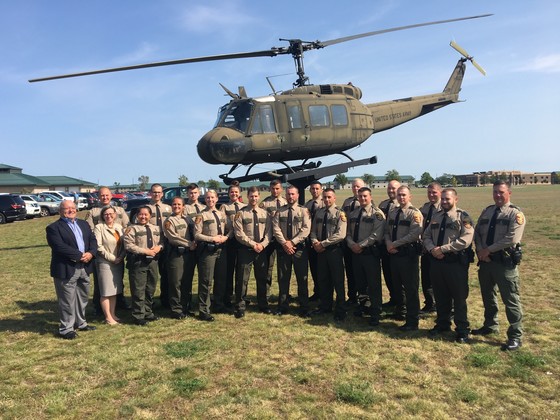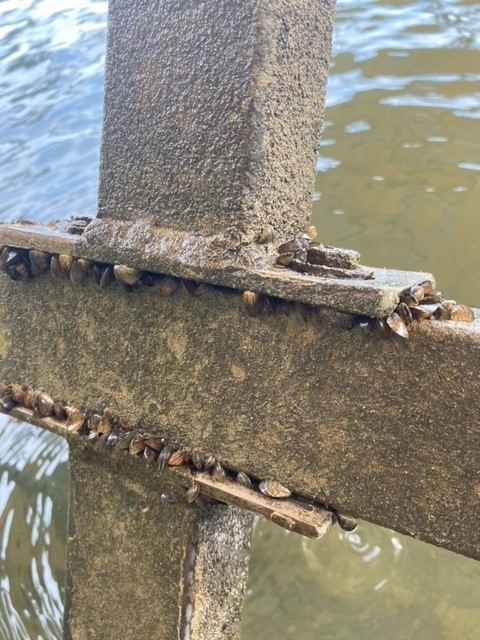In This Issue
 (Front row, left to right) Assistant Commissioner Bob Meier, Commissioner Sarah Strommen, Choua Khang, Cassie Rice, Violet Ohnstad, Ryan Christenson, Dustin Roemeling, Andrew Ladzinski, Benjamin Ulrich, Matthew Paavola, Mason Bulthuis, Col. Rodmen Smith
(Back row, left to right) Brett Fox, Trent Anderson, Jesse Drown, Felicia Znajda, Coby Fontes, Anthony Hams, Hudson Ledeen, Adam Stennett, Dallas Cornell. Photo credit: Minnesota DNR
Eighteen people graduated Tuesday, Sept. 13, from the 21st Minnesota Department of Natural Resources Conservation Officer Academy, after training for 16 weeks in all aspects of their new careers as conservation officers. The graduates already have spread out across the state and will spend the next several months field training with experienced conservation officers before assuming their assigned stations.
The officers have a wide variety of backgrounds and experiences. Some are veterans, while others left jobs as police officers to join the DNR. Others worked as firefighters or dispatchers. Some had no previous law enforcement experience, coming to the DNR via the Conservation Officer Prep program, which provides a pathway for people with at least a two-year college degree to become a conservation officer.
?Each of the officers brings a unique background and experiences, but the common thread that joins them all is a commitment to protecting Minnesota?s people and natural resources and a desire to ensure future generations have the same opportunities we have today,? said Col. Rodmen Smith, director of the DNR Enforcement Division.
The Conservation Officer Academy prepares new officers to occupy vital roles in the communities they serve. During the academy, recruits are trained in all aspects of being a conservation officer and learn from experienced officers and other experts on a wide variety of topics, including education and outreach, fish and wildlife laws, patrol procedures and environmental enforcement. Cadets are tested each week and put through practical scenarios that reflect what they will encounter in the field. During the field training portion of their preparation, cadets work throughout the state with experienced officers before they head for the permanent stations.
Upon conclusion of field training, the officers will work in the following field stations: Baudette #1, Baudette #2, Cambridge, Cook, Madison, Malmo, Montevideo, Ortonville, Osakis, Osseo, Pine River, Rochester #2, Sauk Rapids, St. Cloud, White Bear Lake, Warroad #1, Warroad #2, and Worthington.
Each of the graduates was chosen from among hundreds of applicants and underwent rigorous examinations, psychological profiles and background checks before beginning at the academy.
###
 The Minnesota Department of Natural Resources has confirmed the invasive algae starry stonewort in Thunder Lake, near Remer in Cass County.?
DNR staff conducting a survey of algae in Thunder Lake found starry stonewort. Funding for this research was provided by the Minnesota Environment and Natural Resources Trust Fund as recommended by the Legislative-Citizen Commission on Minnesota Resources.
Follow-up surveys are being conducted to determine the extent of starry stonewort distribution in Thunder Lake. If surveys confirm that starry stonewort is in localized areas of the lake, removal in those areas might be pursued. Such a response could include hand pulling, herbicide applications and other methods as appropriate.
Starry stonewort has never been eradicated from any U.S. lake or river, but treatment or careful removal can help reduce the risk of spread and relieve associated nuisance impacts on water-related recreational activities. Early detection is key to effective management.
Starry stonewort has now been confirmed in 23 water bodies in Minnesota. It was first confirmed in Minnesota in 2015.
In late summer and early fall, starry stonewort?s small white star-shaped bulbils become more visible, making it easier to distinguish from other aquatic plants. Information on how to identify starry stonewort can be found on the?DNR?s website (mndnr.gov/Invasives/AquaticPlants/StarryStonewort). If people think they?ve found starry stonewort or any other invasive species new to a lake or river, they should report it to the DNR by contacting their?area invasive species specialist (mndnr.gov/Invasives/AIS/Contacts.html).
Starry stonewort is an algae that looks like native aquatic plants and can form dense mats, which can interfere with recreational uses of a lake and compete with native plants. It is most likely spread when fragments have not been properly cleaned from trailered boats, personal watercraft, docks, boat lifts, anchors or other water-related equipment.?
Whether or not a lake has any invasive species, Minnesota law requires people to:
-
Clean?watercraft, trailers and equipment to remove aquatic plants and prohibited invasive species.
-
Drain?all water and leave drain plugs out during transport.
-
Dispose?of unwanted bait in the trash.
-
Never release?bait, plants or aquarium pets into Minnesota waters.
-
Dry docks, lifts and rafts for 21 days?before moving them from one waterbody to another.
These additional steps reduce the risk of spreading aquatic invasive species:
-
Decontaminate watercraft and equipment ? find free stations on the courtesy decontamination page of the DNR website (mndnr.gov/Decon).
-
Spray with high-pressure water or rinse with very hot water (120 degrees for at least two minutes or 140 degrees for at least 10 seconds).
-
Dry watercraft and equipment for at least five days before using in another water body.
More information is available on the aquatic invasive species page of the DNR website (mndnr.gov/AIS).
###

The Minnesota Department of Natural Resources has confirmed a report of zebra mussels in Crooked Lake, near Holmes City in Douglas County.
A Crooked Lake property owner contacted the DNR after finding numerous adult zebra mussels on equipment being removed from the water for the season. A DNR invasive species specialist found six juvenile zebra mussels in the public access area of the lake.
Whether or not a lake has any invasive species, Minnesota law requires people to:
-
Clean watercraft, trailers and equipment to remove aquatic plants and prohibited invasive species.
-
Drain all water and leave drain plugs out during transport.
-
Dispose of unwanted bait in the trash.
-
Never release bait, plants or aquarium pets into Minnesota waters.
-
Dry docks, lifts and rafts for 21 days before moving them from one water body to another.
These additional steps reduce the risk of spreading aquatic invasive species:
-
Decontaminate watercraft and equipment ? find free stations on the courtesy decontamination page of the DNR website (mndnr.gov/Decon).
-
Spray with high-pressure water or rinse with very hot water (120 degrees for at least two minutes or 140 degrees for at least 10 seconds).
-
Dry watercraft and equipment for at least five days before using in another water body.
People should contact a Minnesota DNR aquatic invasive species specialist (mndnr.gov/Invasives/AIS/Contacts.html) if they think they have found zebra mussels or any other invasive species.
More information is available on the aquatic invasive species page of the DNR website (mndnr.gov/AIS).
|
|
